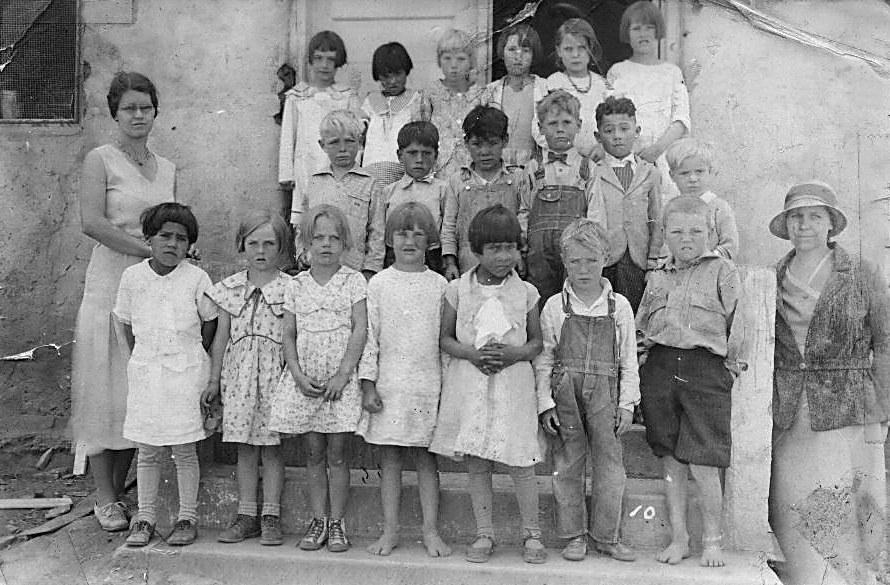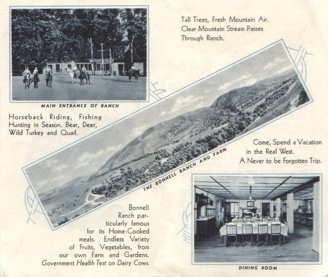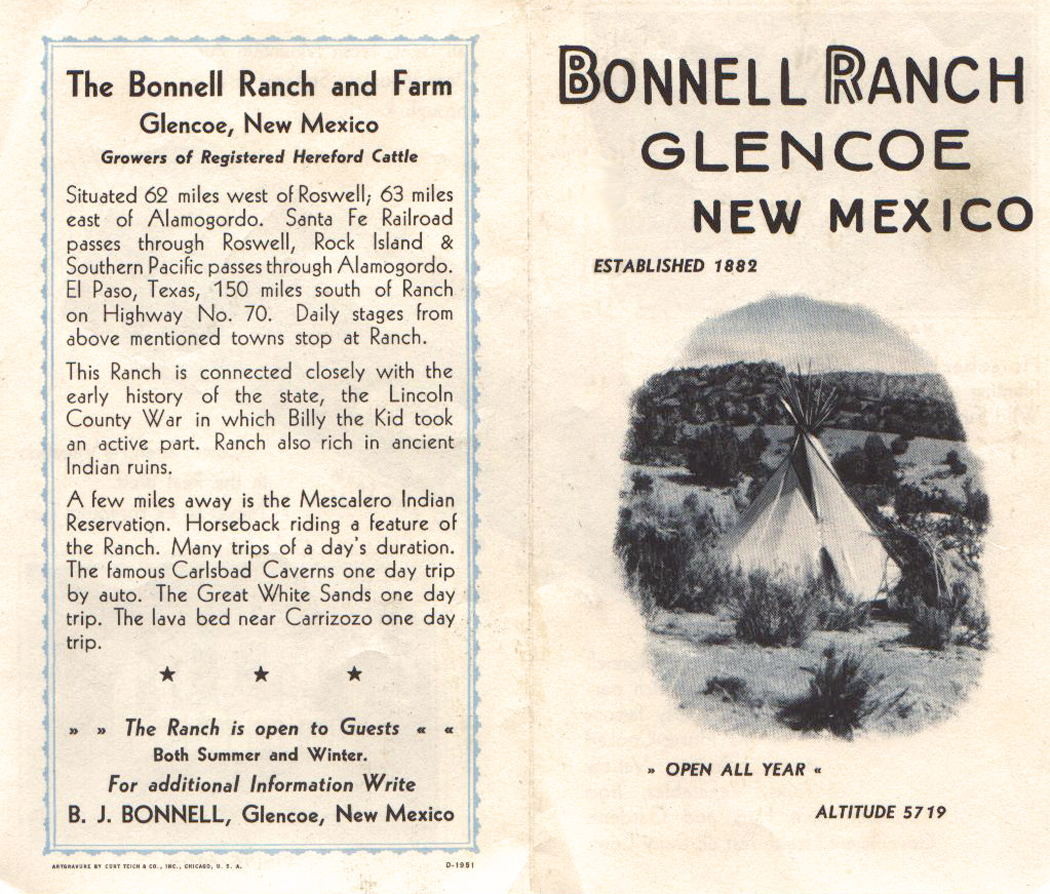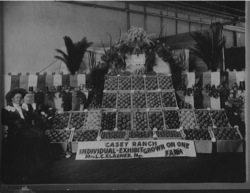







Arrival in the Hondo Valley and Making a Living (Jones 1)
SRB Nellie Ruth, when did your family first come to this area?
NJ: My grandfather, Frank Coe, first came in probably about the late 1870s, between ’75 and ’78, maybe. And he settled down at Hondo first, right at the “Y”. Kind of where that old Hondo Post Office is now. Granddad’s brother, Lou Coe, had been here for about two or three years when Frank and his cousin, George Coe, came and took over his [Lou’s] place. And then after the Lincoln County War, Frank had to leave the county for six months. Went to San Juan County and he met my grandmother and they married and came back and first they lived at James Canyon up in Cloudcroft for a year. Then they bought what is now called Coe Ranch, in 1882.
SRB: How did they make a living?
NJ: They raised apples and truck farmed vegetables. They also had other fruits, you know – peaches, pears, cherries. But primarily apples. Granddad ran cattle and a lot of horses and mules, which he sold to the army.
SRB: Where was the main market for the produce and for the animals?
NJ: A lot of it was at Fort Stanton, and then ‘course they took it by wagon loads to Roswell.
Growing Up (Jones 2)
SRB: Where did you grow up?
NJ: Mostly in San Pat [San Patricio]. My mother and dad owned the place across the river Pete Hurd owns now. They sold out to him when I was just a baby, and we spent some time in El Paso, ‘cause my daddy was a cattle buyer who bought cattle in Mexico and brought them to the States for resale. And after he died, in ’43, well, Mother and I moved back up to here, and she took care of her mother, who at that time was living at the farm at San Patrice [San Patricio], rather than at Coe Ranch. That farm had apples. There were no animals on it. Apples, and that farm is now where Michael Hurd lives. And where his gallery is.
Arrival in the Hondo Valley and Making a Living (Jones 3)
SRB: Paul, where did your family come from? And when did they first get here?
PJ: My mother’s granddad came here in 1867, and he settled right there below Tinnie, where those big fields are. As a matter of fact, he’s buried on that place. The first little field as you go east from Tinnie, there’s a little ring of shrubbery and a few rocks around it. He’s buried there. He and one of my great aunts are buried there. She was about 3 months old when she died. And there is an old Mexican man buried there with them that he had rescued from the Indians. And he stayed with them until he died, and he’s buried there.
SRB: How did they make a living?
PJ: Ran cattle, and farmed. They had all those fields – big fields, there. Raised feed, I imagine, for his cattle.
NJ: A lot of the farms in the valley, back in the days when Fort Stanton was an active fort, raised hay and baled it and sold to the fort also. I don’t know that they baled it. They probably took it by wagon-load.
PJ: My father’s folks came here from Wales, and ended up in Roswell. And he worked for the railroad, and they bought this place, where we are now, in 1917. It’s only been in two families. It was in the Sanchez family. They homesteaded it, way back in the ‘80s, and then it passed down in their family until 1917 when grandfolks bought it. And then my dad was killed in 1933. My mother bought this place in 1934, and we bought it in ’64. But I was raised about a mile down east of here, my mother and dad’s. When we married it had an orchard and they raised different kinds of crops. I’ve been through here way back when cabbage was a big crop. Raised awful good cabbage in this country, and it sold good, and truckers would come in and buy it. Or they’d haul it to El Paso and Roswell and sell it, and my folks had some cattle, too.
NJ: After trucks started moving on the highways, truckers bought the apple crops in the Valley, too. They had those bob-tailed trucks would come in get a truck load out, go down, usually to Texas, deeper in Texas, like San Antonio and Houston, and places like that.
SRB: Did either of your families have fruit stands along the road?
NJ: My uncle and aunt did. There at Coe Ranch. But they were the only ones I can think of . . .
PJ: I remember a lot of fruit stands up and down here, during the season. But we only had a fruit stand here just two or three years. That was right out along side the road. That was when a lot of the truckers quit coming and there was a bigger profit on apples to sell through the fruit stand.
Social Events and School (Jones 4)
SRB: Nellie Ruth, you grew up in San Patricio. What is it about that community that made it distinct from the other communities in the Valley?
NJ: Well, it was predominantly Mexican, but most of them were, so that is not a distinction, but there were some traditions there that I am not aware of in the other Valley [communities]. For instance, on Christmas morning, the children would all come to the door, knocking, and sang, “Christmas gift! Christmas gift!” And we always had a supply of oranges, and would give them one orange each, and some nuts, or maybe some Christmas candy or something. And that was a big tradition there, all the children who lived within walking distance. In fact some of them rode, because that was their big treat of the day, I think, was that orange. Things have really changed. And another tradition was, of course, that San Patrico and the old Catholic Church was called San Patricio. And St. Patrick’s. And so on St. Patrick’s Day there was always a big mass at the little church and even when I was teaching school at San Patricio, we more or less turned out school for that morning because everybody went to mass. And then in the afternoon, school resumed, but it was a party time. We had cake and punch and played games and things like that. And there was a – whenever there was a wedding or a christening or something, there was always a baile dance, which I think is probably pretty true of all of Lincoln County. There were a lot of families that were related to each other, two or three ways, you know, who’d have intermarried. Sisters [from one family] married brothers [from another family], and then somebody else was a cousin over here, so there was a connection between almost any of the people to another family there, or two or three families.
SRB: How big was the school [at San Patricio]? How many kids?
NJ: It was a four-room school, and I only attended eighth grade there at San Patricio, but there were only six of us in that grade. The primary grades were fuller, because the little children came to school, and as they got older, even by eighth grade most of the boys had dropped out and were working at some trade. But the primary grades usually ran about 20 each.
Everyday Life and Social Events (Jones 5)
SRB: What was everyday life like in San Patricio, apart from the special things you already mentioned?
NJ: It was just a usual day, you know. The children went to school. You milked your cows, you fed your chickens, if you had a pig, you slopped the pig. Of course in the spring and summer, gardens were worked. We didn’t get electricity until about ’47 through here. Something like that. It was well after the war. And so you saw a lot of people hauling water, chopping wood, and most houses had a cistern where they collected water, the rain water, so that they could have good drinking water and not drink the water that came from the ditch, even though at that time it was fairly safe compared to what it is now.
SRB: Were there community social events that people went to regularly?
NJ: Well, during a political year, yes. The Democrats would have a rally. It didn’t matter what party you belonged to, you went to that rally. And they always had a cake sale to raise funds. So every woman brought a cake. Sometimes they had box suppers, with – there were a lot of school activities. Any time there was a program, well, everybody in the community came. And of course they had commencement then, out of the eighth grade, and that was a big occasion. The church had a lot of different activities. The women’s groups. I don’t know that they were formalized, but they did little fund-raising things. And the politicians – ALL of the politicians came, not just the county ones, but the state ones. And at San Patrice [San Patricio], it was always held at the old Gato Blanco Bar. It was the “white cat” in translation. And it was a bar with a big dance hall.
Roads (Jones 6)
NJ: I’ve heard some of the old-timers, like my uncle, talking about before the road was paved, how each person had to give so many days to road work to keep it smoothed off and graveled and the mud holes raked out, and so forth. And I remember Uncle Burt Bonnell saying that his portion was 5 days a year to work the highway. I’m sure they were glad when it was paved and that was not an annual chore.
PJ: The county took over – they did that in 1932, I believe.
NJ: Yeah, that’s when that road was started – the paving of it.
Social Events (Jones 7)
SRB: What kind of social activities or community activities were there in Glencoe? Or places that people gathered?
NJ: Probably at Uncle Bert’s [Bonnell Ranch].
PJ: Yeah. Down here at Bonnell Ranch they had dances. They had a dude ranch in the summer and they had dances down there. Well they had dances off and on all year long. And that was about the only place they had social events. A bunch of the men up and down the valley had a baseball team, and they played baseball. Go up here to Hollywood, as we know it, it’s right there – you know where it is.
SRB: Yes.
PJ: They’d go there and Fort Stanton and Capitan, and so forth, and they’d play baseball games. And then rodeos. They had rodeos round pretty regular all during the summer and spring.
NJ: There were several rodeos ‘cause there’d be one at Fort Stanton, and there was one at Ruidoso, Mescalero, and then Carrizozo had a rodeo there on the reservation.
PJ: Right there south of Ruidoso Downs at Turkey Canyon they had a rodeo.
NJ: And at one time they had them in San Patricio, because my middle daughter is married to John Thomas, and Johnny talks about being in a rodeo at San Patricio. So I think a lot of these communities had little ol’ rodeos, kind of like they have team roping events now.
SRB: Did people come from the various communities up and down the valley?
NJ & PJ: Yeah.
PJ: Yeah, that was a big thing, the rodeo. Guys from all over came to compete, and their families came, and friends, and lot of those places didn’t have a fence around the arena, and they’d use parked cars as a fence.
NJ: And after the rodeo was over, well, they’d have a big meal and dance and usually spend the night.
Social Events (Jones 8)
SRB: What were the dances like at Bonnell’s?
NJ: The family had what we called the Coe Ranch Musicians. Uncle Wilbur played the fiddle and then either his wife played the piano or his sisters, Aunt Sydney or my mother, Helena. And cousins played the guitar. They were George Coe’s grandsons. Harold Coe and Elzy Perry, Jr., and then Ralph Bonnell started playing the guitar in his older years. But it was pretty much just a little family band. Music, piano and guitars. And usually just one fiddle player.
PJ: They had those family bands all around this country, like over around Bonita and up in there, and they’d have these dances in homes. And people just come to a home like that – a big brood, and they’d get together and play in bands.
NJ: And it was multi-generational. It wasn’t just the young marrieds, or the older couples. You know, there would be great grandparents down through great grandchildren. And you’d see babies piled up on the beds, you know.
SRB: Did they hold the same kind of dances in San Patricio in that dance hall?
NJ: That was fiddle and guitar music, but it was the Spanish rhythm. But it was basically the same type of instruments.
Social Events (Jones 9)
NJ: I just happened to think of another activity that made San Patricio pretty unique was that they used to have polo games there at Peter Hurd’s place, you know. And I doubt that many of the other communities had, until Anderson came, started to have some there below Picacho.
SRB: Who did they play? Was there one team that played other teams or was it played with different communities?
NJ: Lot of times it was just bunch of old boys . . .
PJ: Some of us’d get together and say we’ll play against you and then sometimes some teams in El Paso that they go down and play, and, or they’d come up here and play, but mostly it was just playing there, just you’re on my side and you’re on my side.
SRB: How often did you play?
NJ: Once a week, anyway.
PJ: Pete had a field. He loved to play polo.
SRB: Was that something that people would come to see?
NJ: Not a lot of them. Some of them would drift up there. ‘Course, the wives of the participants usually were up there.
Making a Living (Jones 10)
SRB: When they put the new highway in, did that affect the fruit stands?
NJ: Yeah. A lot of those fruit stands closed. And of course there wasn’t as much fruit, because a lot of people had taken out their orchards because the market wasn’t as good. Once those truckers stopped coming in the market was not good for apples. And they tried having a co-op – that big building down at Hondo – White Mountain Apple Shed, they called it, didn’t they? And they graded apples there, and sold them.
PJ: What really hurt us – Washington really started raising apples. Their apples came off before ours did, and they colored up so much better than ours that they just took the market and there wasn’t any market for these apples.
NJ: Ours tasted better but they didn’t look as pretty.
PJ: But you could sell apples about the first two weeks here in September, and then Washington came in, why, you may as well forget it. So people started taking orchards out.
NJ: Most of them put in permanent pasture, ran cattle or . . . cattle mostly. No sheep to speak of except just one or two here and there.
SRB: Do you know roughly around what year that Washington raising apples really impacted the sales down here?
NJ & PJ: Early fifties.
NJ: There were some truckers who came year after year after year, you know, and they went to the same orchards, would make several trips to Texas and back.
PJ: Load up three or four hundred bushels, and say “I’ll be back in four or five days. Have me another four hundred bushels ready.” And they always paid in cash.
NJ: Always cash.
SRB: But it was still more profitable to sell on the highway?
NJ: Uh huh.
SRB: When the truckers moved over to the Washington produce, they just didn’t come through here anymore?
PJ: Well, they just couldn’t compete with them.
NJ: They couldn’t compete. It became a dead business.
PJ: Then it seemed to me like we started freezing out more. Used to these orchards would get crops pretty regular. And any more you can figure on it about once every five to seven years – a good crop. Now, why -- I don’t know. Times, weather changes . . . We had an orchard down here awhile, where I was raised, and it got to where it just wouldn’t pay, and so I just cut it down.
Everyday Life (Jones 11)
\
NJ: Fred Lucas. I think Grandmother Coe and Aunt Phoebe Coe probably had a little bit easier life than most women had. They always had some servants, and, like, Grandmother had a cook. Old Man Goss, who – only he wasn’t an old man, then – cut the chains off Billy the Kid so he could escape from Lincoln. Well, he worked for many, many years for Grandmother as a cook. And then they always had some house help. And there was a black man who had been over there during the days of the Lincoln County War, and he came and he divided his time between Uncle George’s family and Frank Coe’s family, helping the children with their music.
NJ: But every evening was music. Mother said not an evening went by that Granddad didn’t gather them all around the piano. She had what was called a square grand piano. They stopped making those in 1865. Some places they’re called a woman’s grand. They’d gather around the piano. Granddad played the fiddle, mostly. And mother said she could remember as a child him teaching her to accompany him while he was playing dance music or something. And if she hit the wrong note, he’d poke her with that bow and she’d never hit it again! She said, man, you learned those right chords real fast, ‘cause that bow hurt. All the children learned to play at least two instruments. Most of them three and four.














